Music is the universal language
“Glory to God in the highest heaven, and on earth peace to those on whom his favor rests.” - Luke 2:14
General Interest
New EarthQuaker Devices Fuzz Pedal
Fender Player II Modified Telecaster – “this guitar just begs to be played for hours”

$1049.99/£949, fender.com
When Fender launched the Player II series last year, it felt like a significant leap forward in the quality and especially playability of the brand’s most affordable Mexico-made instruments.
Fender’s Ensenada factory guitars have also proved to be great modding platforms for pros and weekend warriors alike for decades now, and so it is that less than a year later, the Player II Modified range has sought to do the hard work for you.
Whether it’s Noiseless pickup-loaded Strats or Floyd Rose HSS offerings, the results have been pretty impressive so far – but can they say the same for Leo Fender’s original brilliant electric guitar design? Let’s find out…
 Image: Adam Gasson
Image: Adam Gasson
Fender Player II Modified Telecaster – what is it?
The original Player II Telecaster was a very impressive guitar as it is. And many of the original’s best features are kept for the Modified version – that means an alder body and maple neck with rosewood fingerboard, and yes those ‘board edges are nicely rolled just like the original. That neck is the same 9.5-inch radius’d C-shape as the Player II too.
Another holdover on this test example is a three-colour sunburst finish, but unlike the vanilla Player II it’s accented rather nicely with a four-ply white pearloid pickguard to make it stand out from the rabble.
Under the hood, there’s a lot more going on, however. Most notably, you get a pair of Fender’s Player II Noiseless Tele units – which should come in handy for noisy environments – and more advanced wiring nestling in that body cavity.
In practice that means you get the ability to switch between series and parallel wiring, and there’s also a treble bleed circuit on the volume control to keep things clear and focused as you roll off.
You also get a set of Fender’s locking tuners to make string changes a doddle, while a soft-shell gigbag is included in the price here too – something that was notably absent from the basic Player II range.
 Image: Adam Gasson
Image: Adam Gasson
Fender Player II Modified Telecaster – feel and sounds
One of the chief concerns one might have when buying a conventional Telecaster, or any guitar with only single coils – at least if you are slightly more hard rock-inclined – is that the absence of a humbucker might prove inhibitive.
But thanks to the Player II Modified Telecaster’s push-pull tone pot-activated series mode – which utilises both the neck and bridge pickup at once in series – a sound is included in your palette which very effectively fills that humbucker void.
I’d class myself as a ‘recently country-curious’ player who primarily comes from a hard rock and metal background. With this in mind it’s a very pleasant surprise when I almost automatically dial in a high-gain tone and jam some quickfire palm-muted chugs in series mode.
Look, if you’re looking to venture into extreme metal territory you’re not going to find your perfect match here, but Player II Modified Tele definitely holds its own with heavier sounds with both pickups engaged – no doubt in part due to the Noiseless nature of the design. There’s a reason why Idles were involved in the marketing campaign for these instruments.
 Image: Adam Gasson
Image: Adam Gasson
Fun side note, though: there’s a space between the series-on and series-off settings on the push-pull tone knob where signal is cut entirely, so the more creative among you might be able to use it as a makeshift killswitch and channel your inner Tom Morello.
Moving into the sort of tones that you’d probably expect this guitar to handle, here the pickups show their versatility and their quality – with the Noiseless factor adding real punch and clarity to blues, country and rock licks.
The bridge pickup boasts that classic Tele twang, while the neck pickup has a gloriously warm tone, while retaining a level of articulation by which the guitar just begs to be played for hours.
The treble bleed circuit is another really useful extra tool to have in your arsenal when you’re indulging in grittier tones. The ability to roll off the volume and clean things up without losing clarity adds another string to this versatile instrument’s bow.
If there’s one slight bugbear I have with the guitar straight out of the box, it’s that the action is a little high to really get the most out of the playability. It’s a relatively easy fix that any half-decent tech can handle if you’re not confident with doing it yourself of course, but it’s still suboptimal.
Otherwise, the general fit and finish of everything is truly top class – there are zero noticeable visual hiccups or sloppiness. The neck itself is effortlessly smooth, with those rolled edges really enhancing things again, and it really does feel every bit the road-ready pro instrument.
 Image: Adam Gasson
Image: Adam Gasson
Fender Player II Modified Telecaster – should I buy one?
Fender has expended a fair bit of energy catering to their ‘pro’ market in the shape of the American Ultra II and Ultra Luxe guitars, but those instruments are also priced at a level that many ordinary working musicians can’t really consider.
So for that reason alone, it’s great then that the Player II Modified exists. The standard Player II Telecaster will be plenty of instrument for many players, but if your needs are a little more unconventional and you venture into the heavier spectrum of sounds, this Modified version will be right up your street.
Fender Player II Modified Telecaster – alternatives
You could, of course, go for a non-modified, standard Player II Telecaster (from $839.99/£709) if you’re not overly fussed about the series mode, treble bleed circuit or locking tuners. The previous iteration of the Modified concept was the Player Plus range, and you can still find them kicking around with a healthy discount – they’ll also give you Noiseless pickups and those lovely rolled fingerboard edges.
The post Fender Player II Modified Telecaster – “this guitar just begs to be played for hours” appeared first on Guitar.com | All Things Guitar.
Pedalmania! Keeley, Mr. Black, Hotone, and NUX Demos
As the leaves change and the holiday season approaches, PG contributor Tom Butwin highlights standout pedals from the bevy of tone machines that graced shelves this year. In his first installment of Pedalmania, hear demos of the flexible Keeley Manis Overdrive, Mr. Black's DoubleTracker Stereo, the spacey new Hotone Verbera convolution reverb, and the featured-packed NUX Amp Academy Stomp.
Review: Buck Curran’s ‘Far Driven Sun’ Reunites a Beloved Sobell Guitar with a Master of Acoustic Atmosphere
Remembering Tony Rice: 8 Iconic Licks from the Master Guitarist

In December of last year, Tony Rice passed away. He was/is my all-time favorite guitarist. Like many of his fans, my love of his playing has likely transcended obsession. In fact, at the time of writing this, I have transcribed over 100 Tony Rice solos. That puts me in a unique position to share with you not only my favorite Tony Rice licks but what I think might be Rice's favorite licks, if the frequency with which he played them is any indication.
These examples can be found in almost every Tony Rice break. They are integral to his sound and they can become part of your sound too. This comes with one small warning though: These licks are not meant to be parroted off this page. A big hallmark of this sound is to use these phrases but to vary them, and create your own versions of them. Let's remember Rice by innovating on his past achievements the same way he innovated on the achievements of the players that came before him.
How to End a Bluegrass Song
One of the most famous and enduring Tony Rice licks is this signature tag. A tag is a common way to end a bluegrass fiddle tune or vocal song, the most generic tag being the ubiquitous "shave and a haircut." In Ex.1, you can see what's called a "double" tag. The first tag ends on beat 3 of measure two, before the open 3rd string on beat 3. The remainder of the lick forms the second tag, which eventually morphs into a variation of the Lester Flatt "G run."
Rice's note choice is predominantly major pentatonic but includes an occasional b3 that always resolve down to the 2 or up to the 3. As I say to my students, "Blue notes need buddies." Playing these pairs of notes with articulations like slides and pull-offs that cross bar lines is an important part of Rice's style.
Tony Rice Ex. 1
Use Your Chords
If you're familiar with triads on the D, G, and B strings, you can turn those into bluegrass licks as well. Rice has used the triads in Ex. 2 in a handful of different and interesting ways. He's used the last two chord shapes to form the main riff for "Me and My Guitar," and employed those same shapes to punctuate the end of his "Cold on the Shoulder" kick-off. Sometimes you can see him expand this idea by using even more chord shapes to descend the neck. He would use something like Ex. 2 in a G major context but would be heavily implying G Mixolydian mode by using the F major and D minor triads.
Tony Rice Ex. 2
That One Lick
I've seen this passage referred to multiple times as "that one Tony Rice lick." He uses variations of this passage to finish breaks in "Your Love Is Like a Flower," "Ain't Nobody Gonna Miss Me When I'm Gone," and "Gold Rush." It serves the function of a statement piece to assert his personal voice on the instrument before handing off the spotlight to the next instrumental break or verse of a song with vocals.
As you play Ex. 3 be mindful of how you use your pinky. Every note on the 10th fret is played with the pinky, including a brief pinky barre on the 10th fret of the 3rd and 4th strings.
Tony Rice Ex. 3
Pull-Off Central
This lick has been featured in recordings, but I associate it much more with Rice's live sound. Whenever Rice needs a second to think about what to play next, Ex. 4 seems to come to his fingers first. The note choice here lands firmly in the minor pentatonic camp but he manages to create a little bit of an outside sound with the third iteration of the pattern that brings in the b5 at the 6th fret of the G string.
Tony Rice Ex. 4
Escape Notes
Have you ever been stuck up the neck improvising with no idea how to get back down to something more familiar? Me too! So, let me introduce you to escape notes. Sometimes you can find an open string that will continue your line in a linear fashion while freeing up your hand to shift down the neck. Take a look at the F, E, and D eighth-notes in the first measure of Ex. 5. Rather than playing those three notes in position, Rice is using the open 1st string so he has time to shift his hand while continuing his eighth-note line.
There are examples of Rice using variations of licks like this in "Blue Railroad Train," "A Hundred Years from Now," and "Likes of Me." You can use this in a D major context or in a G major context over a D chord.
Tony Rice Ex. 5
Acoustic Bends
It can be done, and in a situation like this we're not necessarily shooting for something perfectly in tune. In Ex. 6 you can see that pulling down on the 4th string at the 3rd fret will bring the note closer to F#, the 3 of the chord, but in practice Rice usually doesn't get all the way there.
Tony Rice Ex. 6
Phrasing
If you asked a random flatpicker at a bluegrass festival to play a Tony Rice lick, they would probably play something like Ex. 7. These types of phrases have endless variations and demonstrate Rice's long-standing influence on bluegrass music. These licks are built from a G minor pentatonic (G–Bb–C–D–F) bone structure but always feature a pull-off from the 2nd fret to the 1st fret on the B string and a slide from 3rd to 4th fret on the G string. This pull-off and slide are great reminders that blue notes need buddies.
Tony Rice Ex. 7
True Minor
Bluegrass isn't all major tunes though. There are standards in minor keys. We're talking about tunes that are actually minor—not just playing minor pentatonic licks over major chords. With that in mind, it would be wrong of me to not mention Ex. 8, one of Rice's favorite improvisational ideas to employ over minor tunes. This kind of lick is all over Rice's original compositions in minor keys and the recordings he made with David Grisman. The idea is framed in a slightly ambiguous way, so you can find Rice using it in A minor and D minor.
Tony Rice Ex. 8
It's an impossible task to completely distill Tony Rice's playing into a single lesson. I would point you to nearly any album in his discography to get the essence of modern bluegrass guitar right from the source. His touch, feel, tone, and vibe forever changed acoustic music and we all will be eternally grateful.
Essential Tony Rice Videos
Tony Rice liked to perform "Me and My Guitar" with an extended jam in the middle. Many licks from this lesson appear in his guitar break at 6:00.
Tony Rice's "Church Street Blues"
There's very little footage of Tony Rice performing his iconic interpretation of Norman Blake's "Church Street Blues." This arrangement may be one of the most difficult to replicate from Rice's catalogue.
Tony Rice's "Old Home Place"
Tony Rice performs on the definitive recordings of multiple bluegrass standards but "Old Home Place" may be the most important. JD Crowe & The New South's self-titled release is considered by many to be a near perfect bluegrass record.
Tony Rice "Shenandoah"
Most folks talk about Tony Rice's hot-style playing but his melodic chord melody approach to guitar is equally impressive. I doubt we'll ever see an accurate transcription or performance of this era of Tony Rice.
Aluminati Guitar Company Introduces the Floodcaster
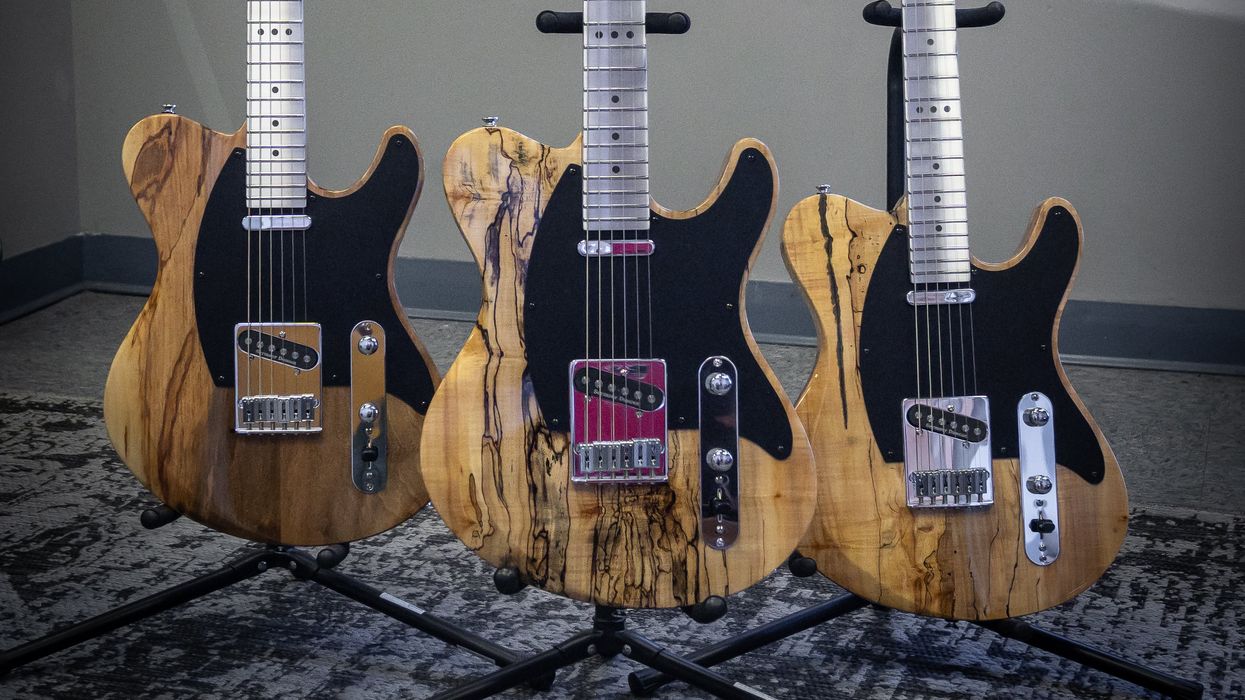
Aluminati Guitar Company, a pioneer in sustainable guitar manufacturing, is proud to unveil the Floodcaster— a guitar with a story to tell. Built from wood reclaimed from the aftermath of Hurricane Helene’s catastrophic flooding in Asheville, these instruments blend history, innovation, and sustainability in a way never before seen in the industry.
When floodwaters surged through Asheville, homes, businesses, and studios were left devastated. Seeking to give new purpose to damaged materials, Aluminati salvaged enough reclaimed wood for a charitable run of guitars. Paired with Aluminati’s precision-engineered aluminum necks, the Floodcaster is a guitar that not only delivers exceptional performance but also tells the story of Asheville’s resilient community.

“Every piece of wood used in the Floodcaster Model has a story, and we’re turning that story into an instrument that players will cherish,” says Aluminati CEO, James Little.
Featuring unmatched sustain, clarity, and durability, the Floodcaster is built for modern players who value both performance and craftsmanship. With reclaimed materials giving each guitar a distinctive character, no two Floodcasters are exactly alike.
Giving Back to WNC
A portion of the proceeds from each Floodcaster sold will go directly to relief efforts in Western North Carolina, supporting communities still recovering from the devastation of Hurricane Helene. By putting these materials back to work, Aluminati is not only creating exceptional instruments but also helping rebuild what was lost.
After the initial release, Aluminati plans to partner with high-profile guitarists who will play and sign a select number of Floodcasters. These one-of-a-kind instruments will be sold at auction, with a portion of proceeds going directly to WNC relief efforts.
The first run of Aluminati Floodcasters will be available for purchase at $6,999 on Aluminati’s website, September 27th, 2025.
Floodcaster Specs:
- Aluminati HollowCore™ Aluminum Neck
- Aluminum Fretboard
- Sperzel Locking Tuners
- Jescar Jumbo Stainless Steel Frets
- Bolt-on Brass Nut
- Seymour Duncan ¼ Pounder Tele Pickups
- 3-way Toggle with a reverse control plate for volume swells.
- Gotoh Modern Tele Bridge
- Reclaimed Spalted Maple Body
- 25.5” Scale with 22 Frets
- 12” Radius
- D Shape neck
- Hand Wired and Finished
- 250k Bourne Pots
Selling your gear to make room for more? Reverb Wallet grants exclusive perks to sellers keeping their earnings on Reverb

Hot on the heels of the recent announcement that the marketplace was reducing its fees for sellers – down 3% to just 5% now – and adding a slew of smarter selling features, Reverb is continuing its innovative streak with a new Wallet experience.
Principally, sellers can now get even more value for their music gear by keeping their earnings from sales in their Reverb Wallet, and consequently take advantage of a 1% cashback bonus, faster earnings and future access to “exclusive perks that can help them fund their new sound faster”.
So, essentially at its core, Reverb Wallet offers sellers an alternative to cash for their gear sales, and the option to boost their earnings if keeping them within the Reverb ecosystem – certainly good news for sellers looking to shift gear to make space for more in their collection.
“One of the most important parts of music making is trying out new sounds,” says Reverb’s Chief Technology Officer, Jason Wain.
“Whether you’re upgrading from an Epiphone Les Paul to a Gibson, or starting a new project that needs the dreamy tone of a Roland Juno rather than the gritty sound of the Moog Grandmother, we want to make that journey as easy as possible.
“With Reverb Wallet, players get access to more gear when they turn their old guitars, synths, pedals, and other instruments into higher earnings that help them refresh their rig.”
Reverb says its new Wallet feature is backed by a “trusted and regulated payments platform”, and will see users granted access to “exclusive perks over the coming months”.
In terms of how Reverb Wallet works in practice, sellers can opt in by visiting “Shop Settings”, and selecting “Reverb Wallet” in the payment settings section on the “Policies” page.
The slew of new features in quick succession follows Reverb’s recent return to independence for the first time since 2019 after being sold by marketplace giant Etsy.
The sale was made possible by two investors: Creator Partners, also an investor in BMI, SoundCloud, Color Studios and Mogul; and Servco, which owns a majority stake in Fender.
Learn more about Reverb Wallet at Reverb.
The post Selling your gear to make room for more? Reverb Wallet grants exclusive perks to sellers keeping their earnings on Reverb appeared first on Guitar.com | All Things Guitar.
EarthQuaker Devices Announces the Barrows Fuzz Attacker
Barrows pays homage to the iconic MKII circuit while adding modern refinements that would make even the most discerning vintage purist weep tears of harmonic joy. At its heart, Barrows features a trio of carefully matched germanium transistors nestled within finely tuned circuitry that has been lovingly coaxed to produce everything from light, singing distortion to crushing fuzz tones with nearly infinite harmonic-rich sustain.
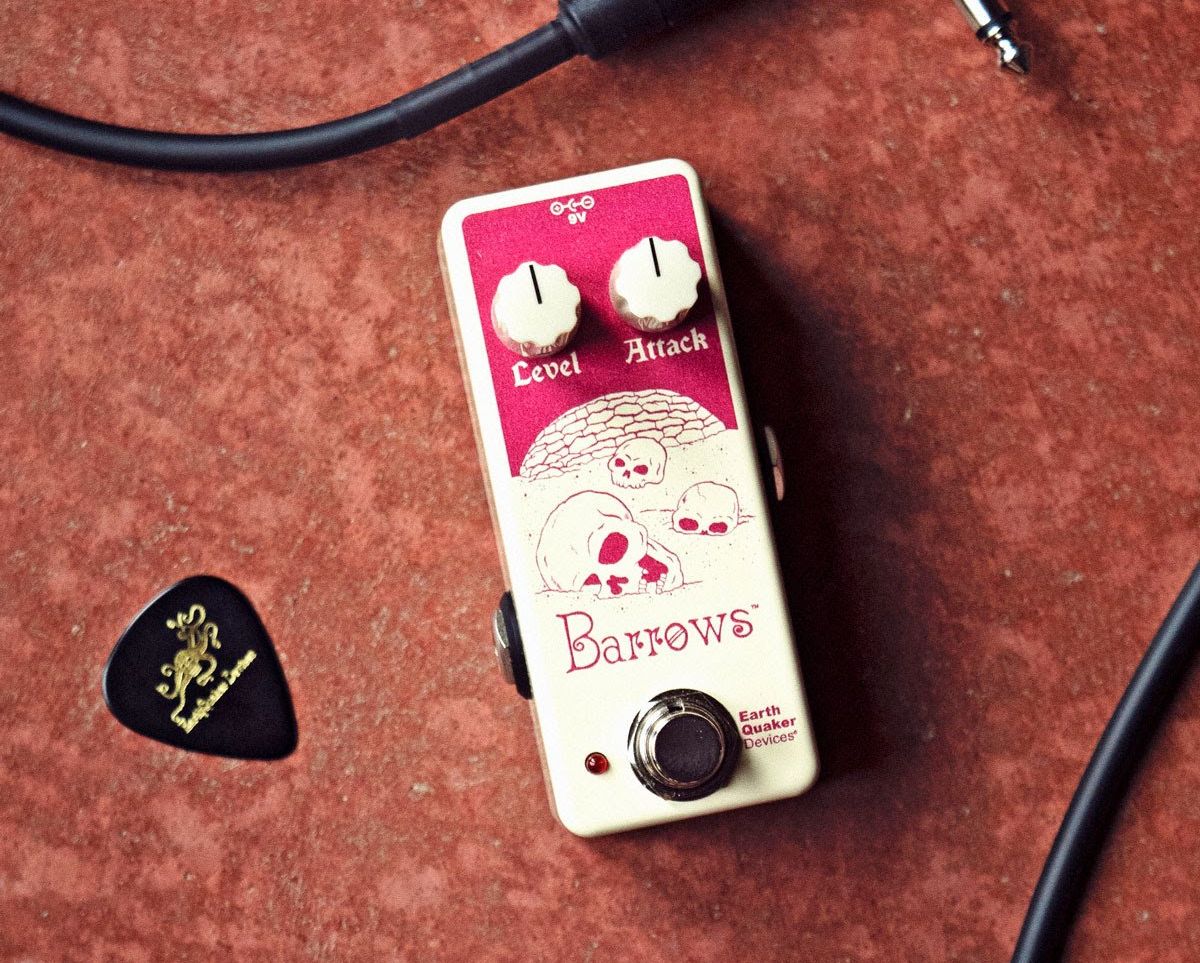
The original MKII circuit was the secret weapon behind some of the most crushing riffs ever committed to tape. From dawn-of-metal caveman dirges to the wall-of-sound symphonies conjured by the highest tiers of shoegaze sorcerers, this legendary topology has been the foundation of countless sonic monuments. Now, with Barrows, you can channel that same lightning-in-a-bottle magic while enjoying the reliability and versatility that modern craftsmanship provides.
At its heart, Barrows features a trio of carefully matched germanium transistors nestled within finely tuned circuitry that has been lovingly coaxed to produce everything from light, singing distortion to crushing fuzz tones with nearly infinite harmonic-rich sustain. This isn’t just another fuzz box – it’s a portal to the fabled tones that have haunted the dreams of fuzz fanatics for decades.
Barrows delivers the signature cutting mid-focused tones with plenty of low-end authority and brilliant top-end grind that made the original MKII a studio legend. But unlike its temperamental ancestors, Barrows includes several modern upgrades that transform it from a vintage curiosity into a contemporary powerhouse.
The phase-corrected and buffered output ensures it plays nice with other pedals down the line, while the increased output volume and wide range of fuzz tones make it a versatile sonic weapon. All this power is packed into a compact footprint that saves precious real estate on your pedalboard, because every square inch matters when you’re building your sonic arsenal.
Gone are the days of finicky positive ground power requirements and battery-only operation. Barrows runs on standard 9V power supplies, making it compatible with any common pedalboard power source. The true bypass switching ensures your signal remains pristine when the pedal is disengaged, while the MKII circuit works its germanium magic when called upon.
Each Barrows is lovingly assembled by shrimply the best helmspeople (and one obedient robot) on the high seas of Akron, Ohio, USA.
Tech Specs:
- Vintage three-transistor germanium fuzz circuit that is based on the Tone Bender MkII.
- Cutting, mid-range focused tones with loads of sustain and volume.
- Very responsive to playing dynamics and guitar volume control.
- Small form factor will fit on even the most cramped pedal boards.
- Mechanical true bypass switching
- Current Draw: 10 ma
- Input Impedance: 50 kΩ
- Output Impedance: <10 kΩ
- Limited lifetime warranty
- Retail Price: $129.00
BOSS Announces XS-100 and XS-1 Poly Shifter Pedals
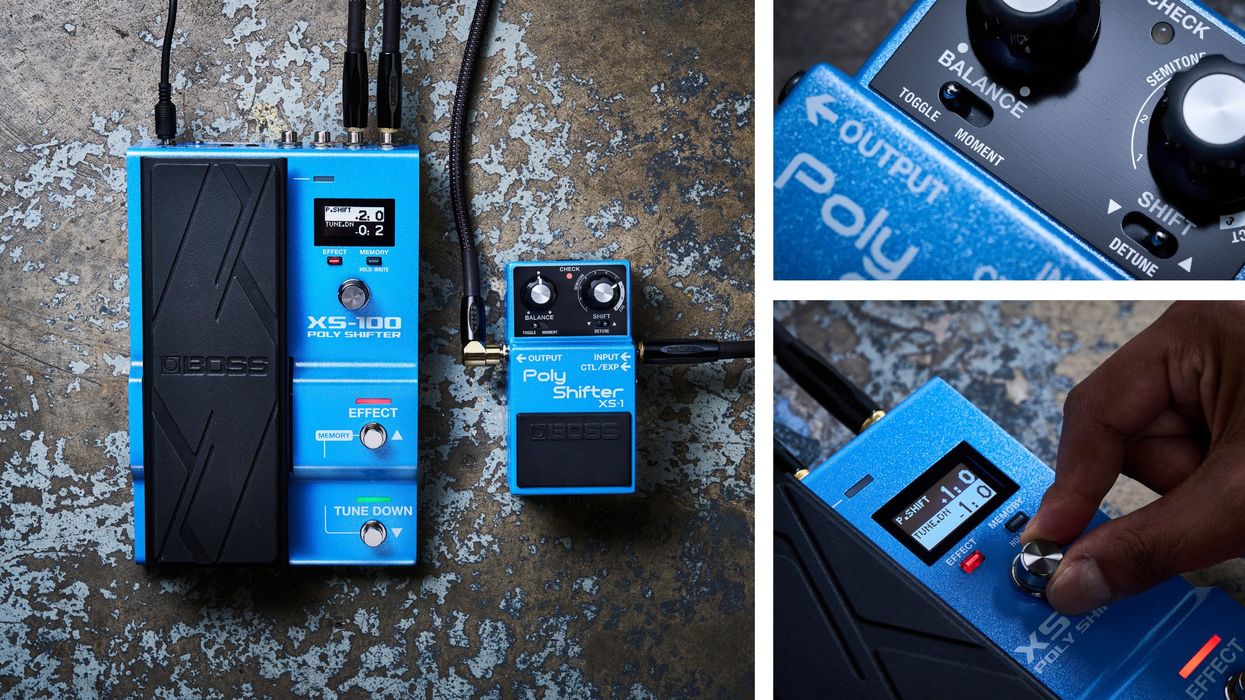
BOSS announces the XS-100 and XS-1 Poly Shifter products, two advanced pitch-shifting effects for guitar, bass, and other instruments. The XS-100 is a pitch-shifting workstation with a massive eight-octave range, real-time pitch control via an onboard pedal and footswitches, and versatile connectivity to interface with other gear. The XS-1 distills the core XS-100 features into the famous BOSS compact pedal format, providing instant drop tunings, capo simulations, octave effects, and linear pitch control with an optional expression pedal.
In developing the XS series, BOSS engineers pioneered new methods to advance real-time pitch shifting and eliminate the tonal artifacts common in conventional designs. Powered by finely tuned algorithms and a specially selected DSP platform, the XS series provides balanced polyphonic performance that feels natural and musical across all playing styles, pickup positions, and pedal setups. The attack and tonal character are fully preserved, and even complex chords and sustained lead tones—typically a challenge for pitch shifters—are reproduced with stunning clarity.
XS-100 Poly Shifter
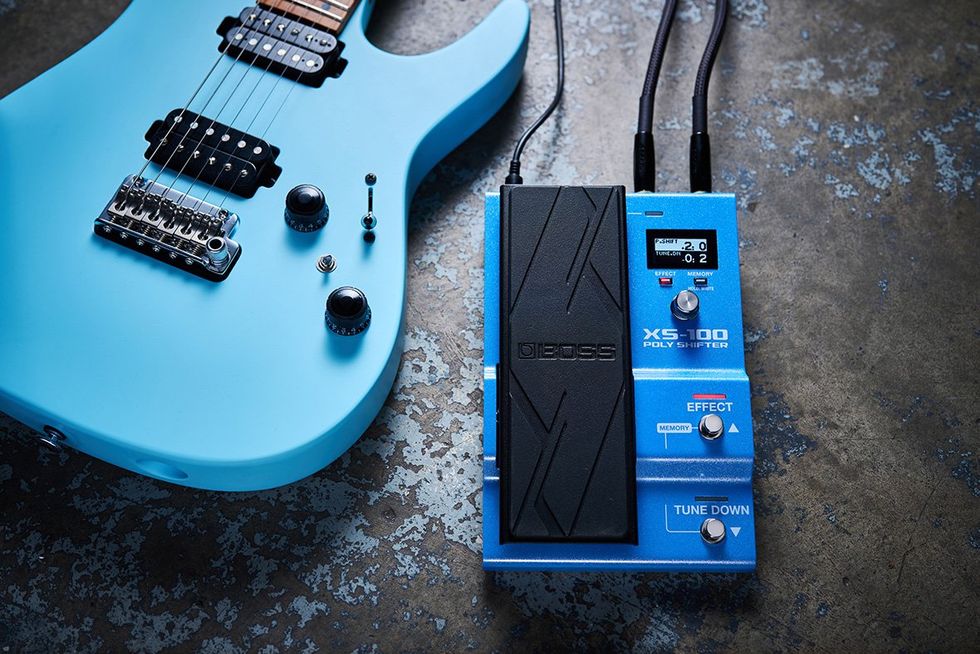
The XS-100 is a powerhouse expression machine that will transform how guitarists and bassists perform with pitch. An onboard pedal provides linear control of four octaves up or down, and independent pitch-change speeds for each pedal direction enable motor revving tones and other interesting effects. At the end of the pedal’s travel, an integrated toe switch can introduce momentary pitch jumps with adjustable range and rise/fall time. Two footswitches are also available to bypass the pedal shift and quickly retune an instrument at fixed semitone steps across eight octaves.
XS-100 users can customize the pedal’s range for different songs or techniques and fine-tune the response curve to suit different playing styles. In addition, the toe switch and footswitches can be reassigned to alternate functions. With 30 onboard memories, players can instantly recall favorite setups during live sets or studio sessions.
The XS-100 supports up to two external footswitches or an expression pedal, expanding the real-time control options. MIDI I/O opens the door to more advanced applications, from external MIDI control to sending MIDI commands with the pedal and footswitches. A secondary output mirrors the input signal, providing parallel routing flexibility for sophisticated rigs.
XS-1 Poly Shifter
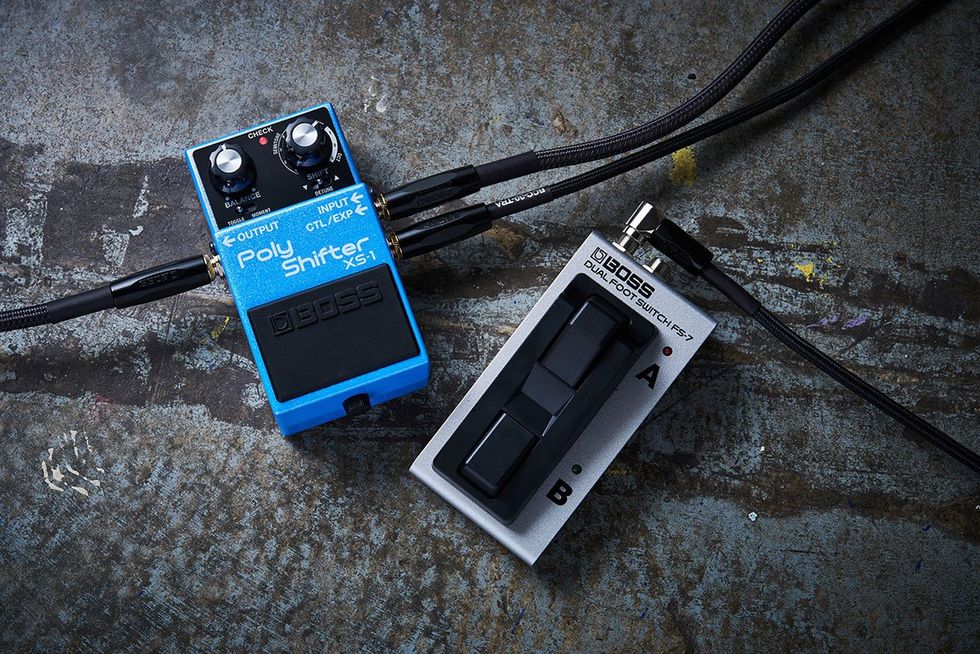
The XS-1 Poly Shifter delivers instant retuning in a convenient pedalboard-friendly footprint, making tuning changes fast, fluid, and seamless. Users can authentically perform songs in drop tunings, change keys to suit a vocalist’s range, play with unique octave-shifted sounds, and more.
Offering a range of +/- seven semitones and three octaves up or down, the XS-1 adapts to virtually any musical need. The intuitive interface features a dedicated Balance knob for adjusting the mix between the direct and effect sound. Turning the knob to effect-only allows for full retuning, while blending in the direct sound can create 12-string effects, parallel guitar/bass sounds, and unexplored sonic colors. There’s also a Detune mode to produce evocative doubling effects with high-definition tone.
The XS-1 provides many control options for different applications. The pedal switch can be assigned for standard on/off or momentary operation, and up to two external footswitches can be connected for fast access to alternate tuning modes with the user’s preferred Balance settings. Alternatively, an external expression pedal can be used to create dynamic pitch-bending effects for dramatic, ear-turning shifts.
Availability & Pricing
The BOSS XS-100 and XS-1 will be available in October 2025 for $349.99 and $199.99, respectively.
For the full press kit (available in several languages), including hi-res images, specs, and more, click here.
To learn more about the XS-100 and XS-1 Poly Shifter pedals, visit www.boss.info.
*USD Price at the time of publishing.
“Fender increased prices to offset higher costs from tariffs”: Report reveals how Fender is tackling tariffs and a “weaker macroeconomic environment”

President Donald Trump enacted hefty tariffs on the import of goods into the United States from countries around the world earlier this year, and they’re continuing to have a heavy impact on guitar manufacturers, including Fender.
Instrument and gear brands have been continually speaking out about the impact of these high tariffs on the guitar trade. Fender’s Executive Vice President Of Product, Justin Norvell, even travelled to Washington earlier this year in an attempt to mitigate the “devastating” impact of the global tariffs alongside industry figures including NAMM’s John Mlynczak and Gibson’s Erin Salmon.
According to a new report from financial information and analytics expert S&P Global [via Guitar World], Fender increased prices throughout the first half of the year to offset higher costs from tariffs, “especially from China, which makes up 40 percent of purchases (half of which enter the US).”
The report further claims that the Big F implemented a five percent price increase in July across its entire portfolio to tough out the financial challenges of the enacted tariffs, but also, it acknowledges the impact of a weaker economy on the business, and explains how sell-in habits – the sales from manufacturers and dealers – affect the brand.
The report states, “Sell-in has exceeded our expectations for retail partners like Guitar Center, SweetWater, and Amazon, as higher-income consumers continue to value the Fender brand.”
Despite this, it also notes: “Nonetheless, volumes continue to decline due to lower consumer discretionary spending, which we expect will continue throughout the remainder of the year. For example, smaller locally owned US dealers continue to tightly manage inventory amid a weaker macroeconomic environment as consumers trade down to the second-hand market or defer discretionary spending.”
S&P Global also claims that Fender is having some success in regards to its entry-level trade; it believes that Fender is “gaining market share” in low-end guitars due to competitor brands allegedly reducing “imports of low-end guitars from China due to tariff headwinds.”
In summary, S&P states: “In 2026, we expect improving volume trends from new innovations, though we continue to expect subdued consumer sentiment resulting in minimal revenue growth. We expect dealers will remain cautious on increasing inventory levels because of a weak macroeconomic backdrop with lower discretionary spending on big-ticket items like guitars.”
It continues, “We expect management will continue to exercise prudent cost management and limit marketing spending and compensation costs to offset its lower gross profit given a weaker macroeconomic environment.”
View the full product lineup from Fender, or find out more on how Fender and other guitar brands joined forces to try and mitigate the impact of high tariffs.
The post “Fender increased prices to offset higher costs from tariffs”: Report reveals how Fender is tackling tariffs and a “weaker macroeconomic environment” appeared first on Guitar.com | All Things Guitar.
Darkglass Electronics Launches “Entropia”
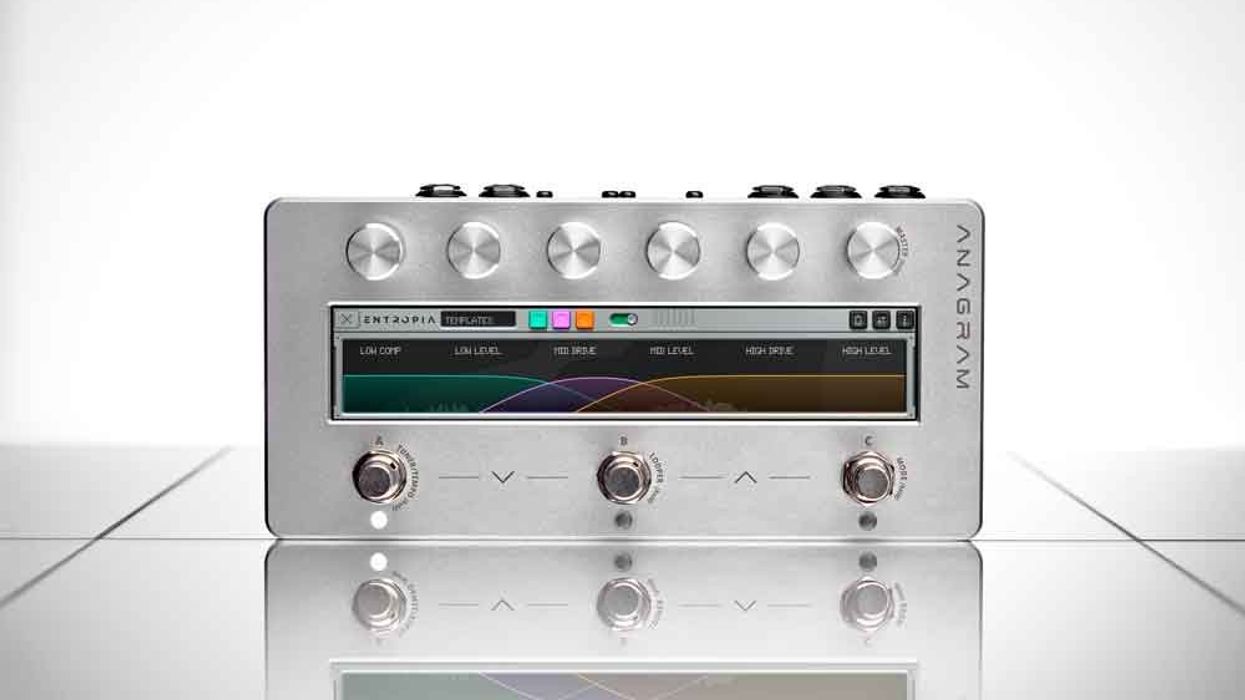
Darkglass Electronics, a global leader in high-end bass amplification and effects, proudly announces the release of Entropia, a groundbreaking multiband compression and distortion plugin designed exclusively for the Anagram platform.
Inspired by the concept of entropy, the natural progression from order to disorder, Entropia empowers musicians and producers to deconstruct and reshape sound with surgical precision. Featuring three fully independent bands (low, mid, and high), Entropia offers unparalleled control over tone sculpting, enabling users to bend, break, and rebuild their sonic landscape.
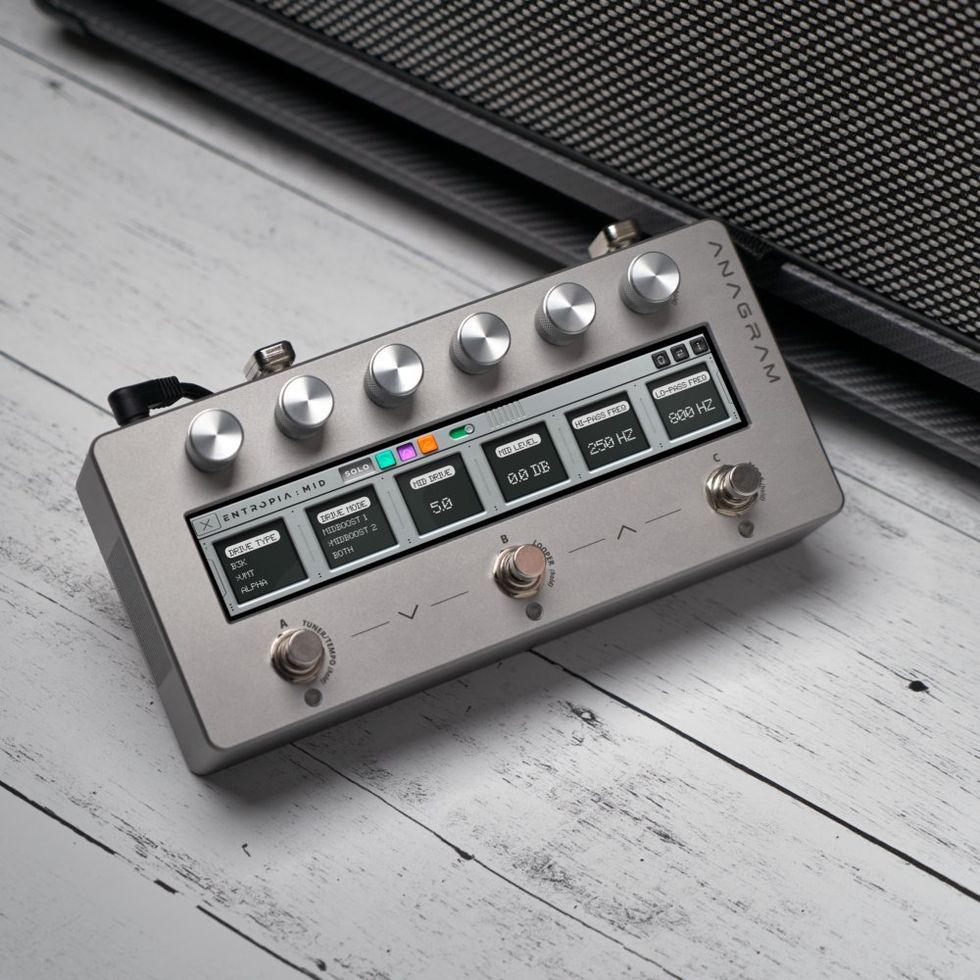
“With Entropia, we open a new door,” said Marcos Barilatti, Director Manager at Darkglass Electronics. “This plugin marks a pivotal step toward a new generation of modular tools for the Anagram platform. It expands the creative possibilities of what Anagram can achieve.”
Entropia introduces a powerful new feature called Templates, expertly curated presets that serve as intuitive starting points for tone creation. These templates allow users to explore the plugin’s full potential with ease, making it accessible to both seasoned professionals and curious newcomers. Unlike traditional distortion plugins that overwhelm the signal, Entropia offers a refined approach to sonic chaos. It’s not just compression and distortion, it’s the artful distribution of entropy, giving users the ability to shape sound with intention and clarity.
Availability
Entropia will be available for download via the Darkglass Suite app starting September 25, 2025. Please note: Anagram pedals will not update automatically. To install Entropia, users must connect their pedal to the desktop Suite and manually initiate the update.
For more information on Entropia please visit www.darkglass.com
DOD Unleashes the Overdrive Preamp 250-X – A New Chapter in a Legendary Pedal’s Story
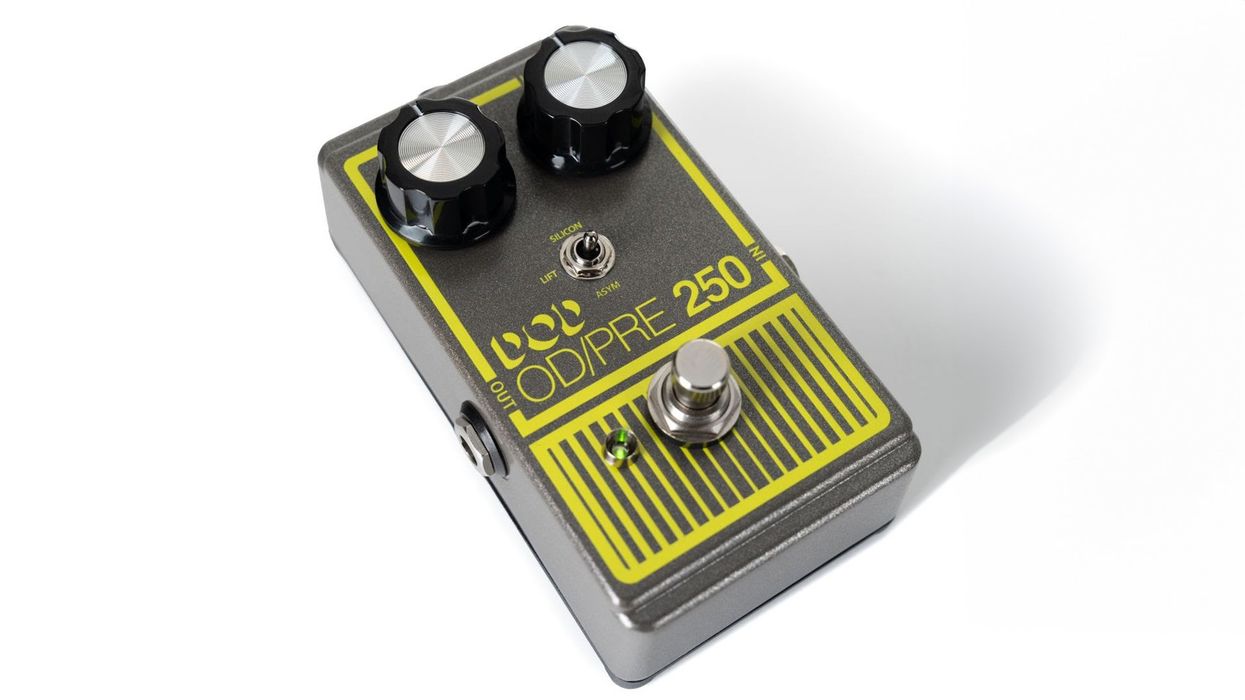
DOD today announces the release of the Overdrive Preamp 250-X, the 10th iteration of its legendary OD250 pedal. Available worldwide through local and online retailers, the 250-X delivers unmatched tonal versatility for players of all skill levels and musical styles. With three distinct distortion modes and modern refinements, the 250-X offers a fresh take on their time-tested classic at a new price point that strives to outperform its contemporaries in its category.
Inspired by the limited-edition DOD OD250-50th Anniversary model released last year, the 250-X (X representing the 10th iteration) offers the same three-position toggle switch function but in an imported, mass-produced model, at a more affordable price.
Operation is straightforward and intuitive. At its core, the 250-X retains the same Gain and Level control values and tapers as the original OD250, preserving the familiar feeling and response that players know and love. The three-position toggle switch expands its tonal range, offers Silicon symmetrical clipping for that iconic 250 sound, ASYM asymmetrical clipping for even-harmonic distortion, and LIFT mode, which removes diode clipping entirely from the signal path for a clean boost at moderate levels or a dirty boost at high levels as it drives the vintage-style LM741 op amp.
Built with an aluminum chassis and weighing in at only 8 ounces (250 grams), construction features true hard-wire bypass, modern 9V DC power input, and +18V tolerant circuitry. With ¼” connections for input and output, the pedal is ready for both stage and studio use making it the most versatile 250 to date.
For more information on the DOD Overdrive Preamp 250-X, visit www.digitech.com.
STREET: $119.99 USD
Heritage Guitars’ Standard II Collection adds “meaningful refinements” to its original Standard Series

[Editor’s note: Heritage Guitars and Guitar.com are both part of the Caldecott Music Group.]
Heritage Guitars has unveiled its Standard II Collection, described as a refinement of its original Standard Series, and it’s kicking things off with the newly updated H-150.
The launch continues Heritage’s 40th anniversary celebrations, with 2025 continuing to be a “landmark year” for the brand. So far, Heritage has also notably debuted the Custom Shop H-717 archtop and the Ascent Collection: a line of accessible instruments designed to bring Heritage’s craftsmanship to a wider audience.
Marking the first model in the Standard II collection, the refreshed H-150 introduces several key enhancements in construction, tone, and versatility. It offers an updated headstock with a new veneer featuring the ‘Heritage’ logo, and its body is crafted from genuine mahogany with weight relief, offering greater comfort without compromising on tone.
It has a ’60s neck profile, which is slim for ample grip with a vintage-inspired feel, and it also comes in brand-new finishes including Wine Red, Bourbon Burst, and Chestnut Burst, alongside existing favourites Dirty Lemon Burst and Ebony.
 Credit: Heritage Guitars
Credit: Heritage Guitars
Further diving into tone and electronics, the Standard II H-150 is fitted with new Heritage Custom Shop 225 Standard Humbuckers – designed and wound in-house, and offering a “broad and expressive” tonal range. Built with 42 AWG plain enamel wire (neck) or 43 AWG poly wire (bridge) on Butyrate unpotted bobbins, and 2.5” roughcast Alnico 5 magnets, they feature potted covers to minimise unwanted feedback at higher volumes.
The model is also equipped with series/parallel switching via push/pull tone pots for tonal flexibility, capturing the brightness and clarity of a “single-coil” voice without the volume loss of traditional coil-splitting.
Speaking of the new series, Heritage Guitars adds: “With the Standard II Collection, Heritage Guitars reaffirms its commitment to continual improvement and refining every detail to deliver meaningful upgrades for today’s players, while staying true to its American-made legacy.”
The Standard II H-150 is priced at $2,599. To find out more or view full specifications, head over to Heritage Guitars.
The post Heritage Guitars’ Standard II Collection adds “meaningful refinements” to its original Standard Series appeared first on Guitar.com | All Things Guitar.
Judge orders Gibson’s damages in Dean legal case upped from $1 to $168,000
![Headstock of a Dean guitar [main image], and the headstock of a Gibson guitar [inset]](https://guitar.com/wp-content/uploads/2025/09/Dean-Gibson-new-hero@2000x1500.jpg)
Back in March 2025, Gibson triumphed for a second time in its legal battle against Dean, with the latter having been found to have infringed on Gibson’s trademarks for the Flying V, Explorer and SG. However, that victory was tempered somewhat by the jury’s recommendation that Gibson be awarded just $1 in damages.
Now however, the judge in the case has increased this award, ruling that Dean’s parent company Armadillo Distribution Enterprises Inc, will have to pay Gibson just over $168,000 for the infringement, which is to be taken in disgorgement of profits earned through infringement.
In legal speak, disgorgement refers to the relinquishing or forfeiture of unlawfully obtained profits toward either the state, or in this case, to the party harmed, Gibson.
The original figure was so low because the jury felt that Gibson had waited too long to protect its trademark rights – Dean had been making guitars using the Flying V and Explorer body shapes since the 1970s, but Gibson didn’t take action against them for decades.
Now however, US District Judge Amos L Mazzant – who presided over the case – has decided that the jury’s recommendation is insufficient given the profits made by Armadillo over the period from use of the infringing shapes, and increased the damages to $168,399
Mazzant had the option to treble the damages or award Gibson statutory damages, but he declined to do so as he felt that any further financial punishment for Dean would be “punitive”.
“By requiring Armadillo to disgorge the profits it earned through infringement, the Court places Gibson in roughly the same position as it would have been had the infringement never occurred,” Judge Mazzant wrote in his latest opinion handed down on Monday (22 September).
“Here, statutory damages are unwarranted,” Judge Mazzant said in the ruling handed down on Monday. “The court already determined that disgorgement and injunctive relief are the proper remedy based on the equities of this case and any additional monetary award would be punitive.”
“Also, awarding statutory damages would be duplicative of the disgorgement award.”
The case wasn’t a total loss for Dean/Armadillo, however. While the brand was found to have infringed on the body shape trademarks for the Flying V, Explorer and SG – as well as the ‘Hummingbird’ and ‘Flying V’ wordmarks – but was found to have not infringed on either the ‘Dove Wing’ headstock shape or the ES body shape. In fact the jury even recommended that the ES trademark should be cancelled as it is generic.
In his latest opinion Judge Mazzant declines to elaborate further on this, though it could end up being a hugely impactful part of the case. He also neither accepted or denied Gibson’s request for Armadillo to cover the brand’s legal fees – both of these will be addressed in the final judgement on the case.
However, the injunction handed down now permanently bars Armadillo and Dean from making, advertising or selling products which infringe Gibson’s trademarks. Counsel for both Gibson and Armadillo have not commented on the matter at this time.
Brief history of Gibson vs. Dean
The legal battle between Gibson and Dean goes back to 2019, when Gibson accused Dean’s parent company Armadillo of trademark infringement, trademark counterfeiting, unfair competition and trademark dilution.
Armadillo subsequently launched counterclaims, saying a number of other guitar companies have been selling products with strong visual similarities to Gibson’s designs for decades. It argued, therefore, that Gibson’s trademarks should be cancelled for genericness.
But in 2022, Dean and Armadillo were found guilty of trademark infringement and counterfeiting pertaining to Gibson’s Flying V, Explorer, SG and Hummingbird shapes. At the same time, the jury found that Gibson had delayed in asserting its trademark rights for the Flying V and Explorer body shapes, and the Dove Wing headstock shape.
The case then went to the United States Court of Appeals for the Fifth Circuit, which in July 2024 ordered a new trial after finding that the district court had improperly excluded evidence.
However, after a second seven-day trial in March, Gibson once again triumphed – albeit in a more limited fashion than the first case. The jury found Dean had infringed on the Flying V, Explorer and SG – as well as the ‘Hummingbird’ and ‘Flying V’ wordmarks – but was found to have not infringed on either the ‘Dove Wing’ headstock shape or the ES body shape, and recommended the cancellation of the latter.
Guitar.com has reached out to both Gibson and Dean/Armadillo for comment on the latest ruling.
The post Judge orders Gibson’s damages in Dean legal case upped from $1 to $168,000 appeared first on Guitar.com | All Things Guitar.
Noel Gallagher’s 1960 Gibson ES-355, which Liam Gallagher destroyed right before Oasis’s breakup, is headed to auction – and could fetch up to £500k

There are certain instruments which hold an unassailable place in music history. And Noel Gallagher’s 1960 Cherry Red Gibson ES-355 is one of them.
While Oasis are back now stronger than ever – and in the midst of a world tour, one of the most highly anticipated in history – the Gallagher brothers have had to fight through their share of differences to get to this point.
It was inevitable that the band’s breakup in 2009 would be climactic, and ultimately saw a fight break out between Liam and Noel backstage at the Rock en Seine festival in Paris. The bust-up was not without collateral, either, as Liam grabbed Noel’s ES-355 and swung it “like an axe”, causing the damage which can be seen on the instrument today.
This guitar played a big part in the story of Oasis’s contentious breakup, so now that it’s headed to the auction block, it’s understandable experts are predicting such a high sell price: £250,000 – £500,000, to be precise.
According to PropstoreAuction – the auction house hosting the sale – Liam chose this guitar to swing around because he knew it was one of Noel’s favourites. “So then he leaves and goes to his own dressing room and picks up a guitar,” Noel explained in 2011. “He comes back in and he starts throwing it around like an axe.”
Noel later announced he was leaving Oasis, saying he could no longer work with Liam, and the band subsequently split.
 Credit: PropstoreAuction
Credit: PropstoreAuction
Aside from its big part in Oasis’s 2009 breakup, the ES-355 was used by Noel and Gem Archer during Oasis’s Dig Out Your Soul tour in 2008, as well as extensively in the studio. Archer also played the guitar during the band’s performance of Don’t Look Back in Anger at Wembley Arena in 2008, and Noel played it during an acoustic performance at Koko Club in Camden on 2 November, 2006.
Online bidding for the guitar is open now, with a minimum starting bid required of £125,000. The auction will end on Thursday, 23 October.
Noel Gallagher’s 1960 Cherry Red Gibson ES-355 is just one item in PropstoreAuction’s mega Music Memorabilia Live Auction. Other items headed to the auction block include:
- Noel Gallagher’s Takamine FP460SC acoustic used to record Wonderwall (Est. £200,000 – £400,000
- Lyrics handwritten by Jimi Hendrix for Straight Ahead (Est. £40,000 – £80,000)
- Slash’s 2019 Gibson Les Paul Appetite Burst “Prototype 2 of 2” (Est. £20,000 – £40,000)
- Trevor Horn’s Sarm West Studio 2 Solid State Logic SL 4048E+G Series Mixing Desk (Est. £100,000 – £200,000)
- Michael Jackson’s Smooth Criminal music video white fedora (Est. £40,000 – £80,000)
- Elvis Presley’s original pair of worn Grand Prix sunglasses (Est. £8,000 – £16,000)
“Propstore’s auction is a celebration of music history, with guitars that shaped the sound of a generation, handwritten lyrics that capture the first spark of legendary songs, and personal items that offer a glimpse into the lives of the world’s greatest music artists,” says Mark Hochman, Propstore’s Music Specialist.
“From John Lennon’s unmistakable glasses to Noel Gallagher’s iconic guitars, these are not just collectables; they’re cultural touchstones that have inspired millions. The Oasis online auction is a particular highlight, perfectly timed with the band’s return to the stage, and offering fans a once-in-a-lifetime chance to own a tangible piece of their enduring story.”
Learn more at PropstoreAuction.
The post Noel Gallagher’s 1960 Gibson ES-355, which Liam Gallagher destroyed right before Oasis’s breakup, is headed to auction – and could fetch up to £500k appeared first on Guitar.com | All Things Guitar.
Christone “Kingfish” Ingram picks his six most influential blues guitar albums of all time

Christone “Kingfish” Ingram burst onto the blues scene a decade ago as a teenage electric prodigy. Now the erstwhile son of Clarksdale, Mississippi is back with Hard Road – a new album of modern blues released on his new label Red Zero Records and an upcoming world tour to support it.
Anyone who has had the pleasure of hearing Ingram’s calling down the thunder with his soulful vocals interspersed with searing lead lines – from his signature Fender Telecaster Deluxe no less – will be expecting great things and this album does not disappoint with some stand out guitar moments. More about Hard Road later, but we really wanted to find out more about the records that have inspired Kingfish to become the 2025 blues colossus that he is. So here are his top five – well six actually – influential albums in the man’s own words.
I’ll Play The blues For You – Albert King
“The title track is the first song that I learned how to play – on bass! This album has to be first on the list. The whole record is great but my favourite song has to be Answer To The Laundromat Blues. He’s really digging in. I don’t know if this is a weird statement but I really like blues players that play with a lot of authority – not necessarily fast – they really dig in. Albert King is one of my biggest influences and he does that – especially on this record.”
Showdown – Albert Collins, Robert Cray, Johnny Copeland
“This is a classic amongst blues historians. Well, for me it’s a classic. It was a collaborative thing between Albert Collins, Robert Cray and Johnny Copeland. The first track – T-Bone Shuffle – Johnny Copeland plays one of my favourite solos on that song. I love his opening licks on that solo. I play those licks in my solos and I got them from this record!”
Live At The Regal – BB King
“Man, you can’t mess with this. Yes sir, that’s classic blues – in fact you can’t say classic blues without Live At The Regal. What can I say about the guitar work on this album? Listen to the whole thing! That’s all I can say! I love that sound – When I first started I played a Gibson 355 – that sort of guitar has certainly been part of my journey and sound.”
Are You Experienced? – Jimi Hendrix
“Jimi Hendrix was a big influence on me. Well, look, outside of classic blues – I love a lot of music, I’m looking at my computer right now and there is so much to choose from – this ain’t easy! But this record… I love the whole thing but there is this one song in particular that is special to me – May This Be Love. This song showcases Jimi’s R&B chordal influences and that’s why I love it. It’s beautiful. He was a master of rhythm guitar.”
A Real Mother For Ya – Johnny Guitar Watson
“Yes sir, Johnny Guitar Watson is definitely an influence when it comes to my phrasing, funk playing, he was a great blues player too – just so inspiring. This is just a great record – listen to the title track. So much feel, and humour too. But I need one more, can I have one more?”
Of course!
Superfly – Curtis Mayfield
“Curtis Mayfield has to be here. Superfly is an important album. I always say that Curtis Mayfield was a prophet. History repeats itself and he really prophesied a lot of what we are seeing today for sure man. Not only that but his black piano key tuning and his whole approach opening up the guitar to his melody and rhythm work. This record belongs here for sure. The title track says it all.”
“I don’t consider myself a blues purist. I’ve always had a love/hate relationship with “purists” of the genre. And that’s simply because I jump back and forth – one day I’ll play traditional blues, the next I’m all rocked up and rocking out. But here’s the thing, I will play whatever the hell I want to play, how I want to play it. And not only that, I feel that it’s cool to showcase the influence of the blues as much as the language itself.
“We all know that the blues is the roots – all these other sub-genres like soul, blues rock, rock n roll, they’re all the branches. Ain’t nothing wrong with showing what the blues has influenced. I feel like the more I go out the box musically people will always be able to hear the foundation of the blues in my music because I will always have that no matter what I do. Even if I’m doing a pop record it’s going to have some blues in there somewhere because that’s where I come from.”
 Image: Jen Rosenstein
Image: Jen Rosenstein
You recently set up your own record label – that is an interesting step forward!
“That’s right – Red Zero Records. This was an idea that my manager and I formulated back in 2019. We wanted to create an avenue for a lot of the young blues-based musicians that we felt weren’t getting the recognition they deserved. I’m not the only one that’s out. Here doing it you know – there’s a host of young talent out here and I wanted to help. You have to give back – someone gave me an opportunity and now I’m at a point in my career where I can pass that forward.”
Did you feel a new level of creative freedom?
“Definitely! I feel like everyone knows me for the blues and blues-rock but you listen to this new record and you will hear R&B on there, you’ll hear soul, I really wanted to make a record that would showcase my voice and my vocal range too – and then all the other stuff comes in. Tom Hambridge, Patrick “Guitarboy” Hayes, and Nick Goldston did a great job with the production too – those guys know what they’re doing – I love how this record sounds.”
Hard Road is out 25 September on Red Zero Records
The post Christone “Kingfish” Ingram picks his six most influential blues guitar albums of all time appeared first on Guitar.com | All Things Guitar.
BOSS Introduces Two Pitchshifting Pedals
Boss brings the Whammy into the 21st century with the all-new XS-100

Boss has unveiled its 21st-century answer to the Whammy pedal with the all-new XS-100, as well as a smaller unit adopting the brand’s compact pedal format, the XS-1.
Boasting a huge eight-octave range – and, of course, an onboard pedal for linear control of the four octaves above and below the centre line – Boss is confident the XS-100 is a “powerhouse expression machine that will transform how guitarists and bassists perform with pitch”.
Meanwhile, the XS-1 takes the XS-100’s core features and distills them into the treasured Boss compact pedal format, offering instant drop tunings, capo simulations, octave effects, and even linear pitch control, if pairing with an external expression pedal.
Linear pitch shifting has long been an effect much loved by guitarists. But with the development of the XS series, Boss says it has pioneered new methods to “advance real-time pitch shifting and eliminate the tonal artefacts common in conventional designs”.
“Powered by finely tuned algorithms and a specially selected DSP platform, the XS series provides balanced polyphonic performance that feels natural and musical across all playing styles, pickup positions, and pedal setups,” Boss says.
“The attack and tonal character are fully preserved, and even complex chords and sustained lead tones – typically a challenge for pitch shifters – are reproduced with stunning clarity.
Let’s take a closer look at what both the XS-100 and XS-1 have to offer.
XS-100 Poly Shifter
 Credit: Boss
Credit: Boss
In addition to four octaves both above and below, controllable via an onboard expression pedal, the XS-100 also enables motor revving-style tones via independent pitch-change speeds for each pedal direction.
There’s also an integrated toe switch, whereby at the end of the pedal’s travel, players can experiment with momentary pitch jumps with adjustable range and rise/fall time. Additionally, there are two footswitches which can be used to bypass the pedal shift and quickly retune an instrument at fixed semitone steps across the eight octaves.
The pedal’s range is also customisable, meaning musicians can create different presets for specific songs and bank them to 30 onboard memory slots.
And if one pedal wasn’t enough, the XS-100 supports up to two external footswitches or an expression pedal, further expanding real-time control options. There’s also MIDI I/O functionality for more advanced applications, like sending MIDI commands using the pedal and footswitches.
XS-1 Poly Shifter
 Credit: Boss
Credit: Boss
Meanwhile, the XS-1 doesn’t have an onboard expression pedal – though an external one can be integrated – and is thus packed into Boss’s smaller compact blueprint for a more pedalboard-friendly footprint.
Offering a range of seven semitones and three octaves up or down, the XS-1 can be used for a variety of applications, including drop tunings, key changes, or capo simulation, to name a few.
Its easy-to-grasp interface features a dedicated Balance knob for adjusting the mix between wet and dry signal, while there’s also a Detune mode for experimenting with doubling effects.
The XS-1’s pedal switch can be assigned to on/off for momentary operation, while up to two external footswitches can be connected for quick access to alternate tuning modes with your preferred Balance settings. An external expression pedal can also be used to turn the XS-1’s operation more into that of the XS-100.
Pricing and availability
Both the XS-100 and XS-1 will be available in October 2025, priced at $349.99 and $199.99, respectively.
For more information, head to Boss.
The post Boss brings the Whammy into the 21st century with the all-new XS-100 appeared first on Guitar.com | All Things Guitar.
EHX Releases Bender Royale Germanium Fuzz
What’s Inside: Fretboard Journal 57
As we celebrate the 20th anniversary of the Fretboard Journal, our new 57th issue serves as a reminder that great guitar stories are literally everywhere. This time around, we travel to the northern reaches of England, explore the electronics that helped expand Joni Mitchell’s live rig, pay tribute to some fallen guitar heroes, and celebrate the handmade instrument movement.
Here are some highlights found in this issue’s 128 pages.

Joni Mitchell has always pushed the boundaries of songcraft and guitar playing. In this issue’s cover story, writer Clay Frohman describes how, in the mid-‘90s, with some help courtesy of Westwood Music’s Fred Walecki, Joni explored the limits of guitar tech and tuning with the help of a Roland VG-8 synth. Acclaimed guitar photographer Eleanor Jane takes pictures of Joni’s actual rig, from the VG-8 to the guitar Walecki built for her.
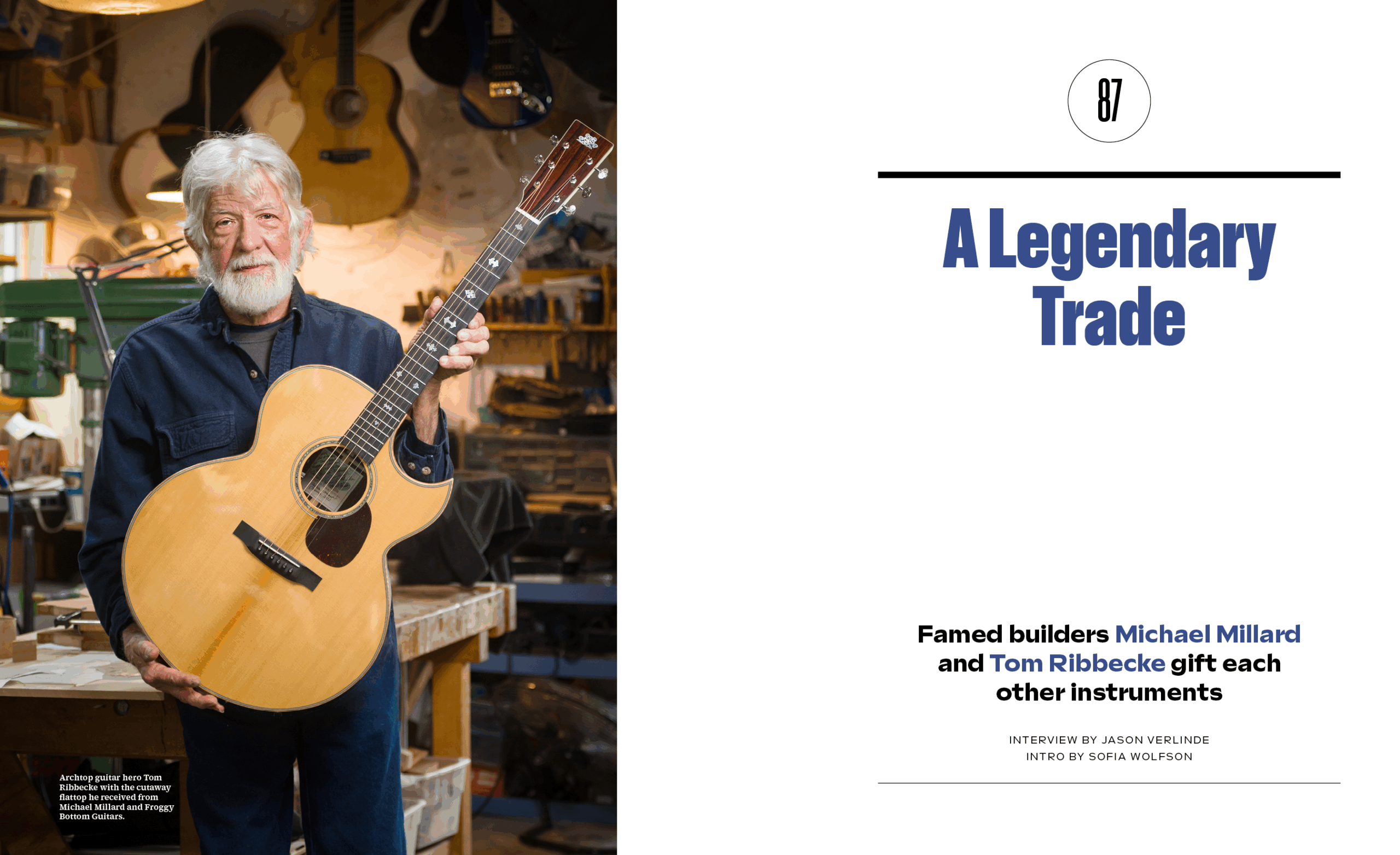
California’s Tom Ribbecke is known for his cutting-edge archtop and bass creations. Vermont’s Michael Millard is a bit more old school; he’s the mastermind behind legendary acoustic flattop company Froggy Bottom Guitars. Fretboard Journal founder Jason Verlinde talks to these decades-old friends about the guitars they just built for each other in the instrument trade of a lifetime.

Contributor Daniel Marcus Clark interviews acclaimed UK-based luthier Stefan Sobell about his craft. Sobell is one of those rare stringed artisans who makes nearly everything, including acoustic guitars, citterns, mandolins and bouzoukis.
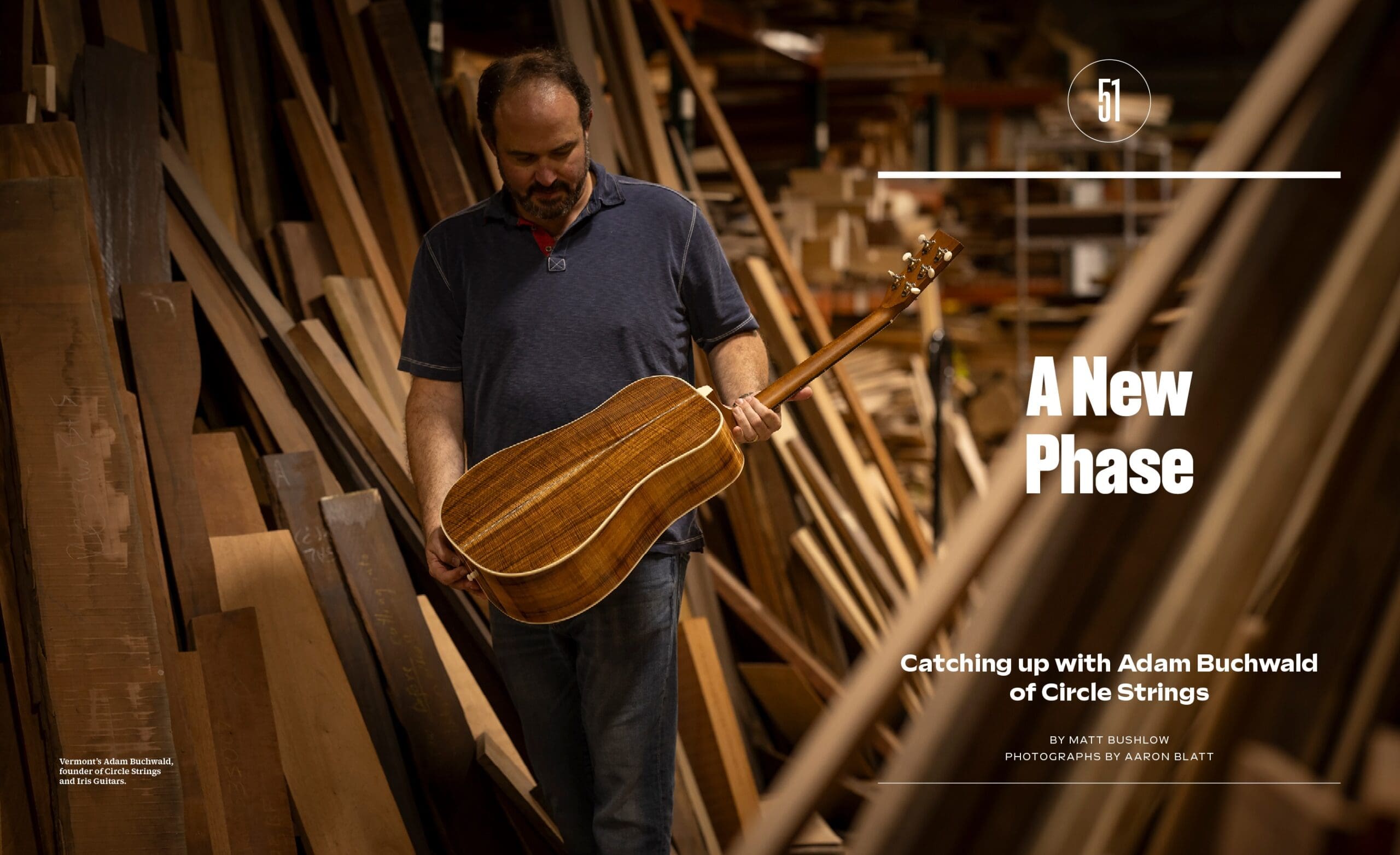
Vermont’s Adam Buchwald has not-so-quietly built one of the fastest-growing guitar companies around. Starting with his high-end Circle Strings imprint, Adam then segued into the budget-minded Iris brand, and is now the current owner of industry suppliers Allied Instruments and Gurian Instruments. Writer Matt Bushlow visits Buchwald and his expansive team at their Burlington headquarters to hear about this mini empire in the fretted instrument space. Photographer Aaron Blatt takes pics of Adam and his team.
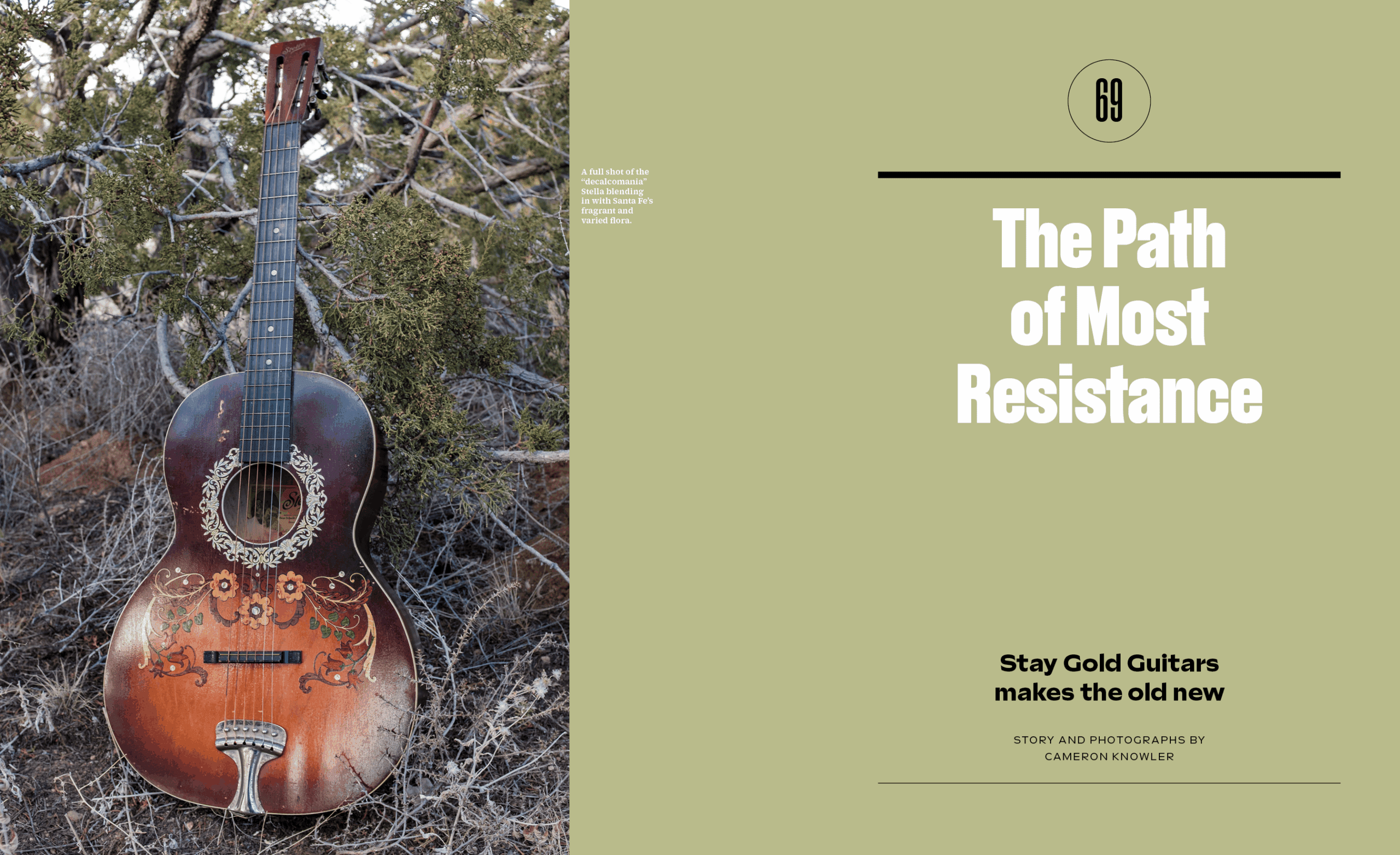
Call it upcycling or maybe hot-rodding. Cameron Knowler interviews Shawn Lee of New Mexico’s Stay Gold Guitars, a store that specializes in taking vintage (but lesser-value) American-made acoustics and rebuilding them for greatness. It’s a place where old Harmony, Bruno and Regal instruments get a second life.

The Fretboard Journal’s Sofia Wolfson interviews singer-songwriter Andy Shauf, a Canadian-born musician with a knack for beautifully orchestrated pop songs. Shauf talks about his creative process and 2, the new album from his band Foxwarren.
Plus Maine folk artist Gordon Bok, vintage Martins, painted cases, and tons of surprises.
Thanks to our community of subscribers, contributors, and sponsors for helping make this issue a reality.
Want this issue? Subscribe today and we’ll send it to you.
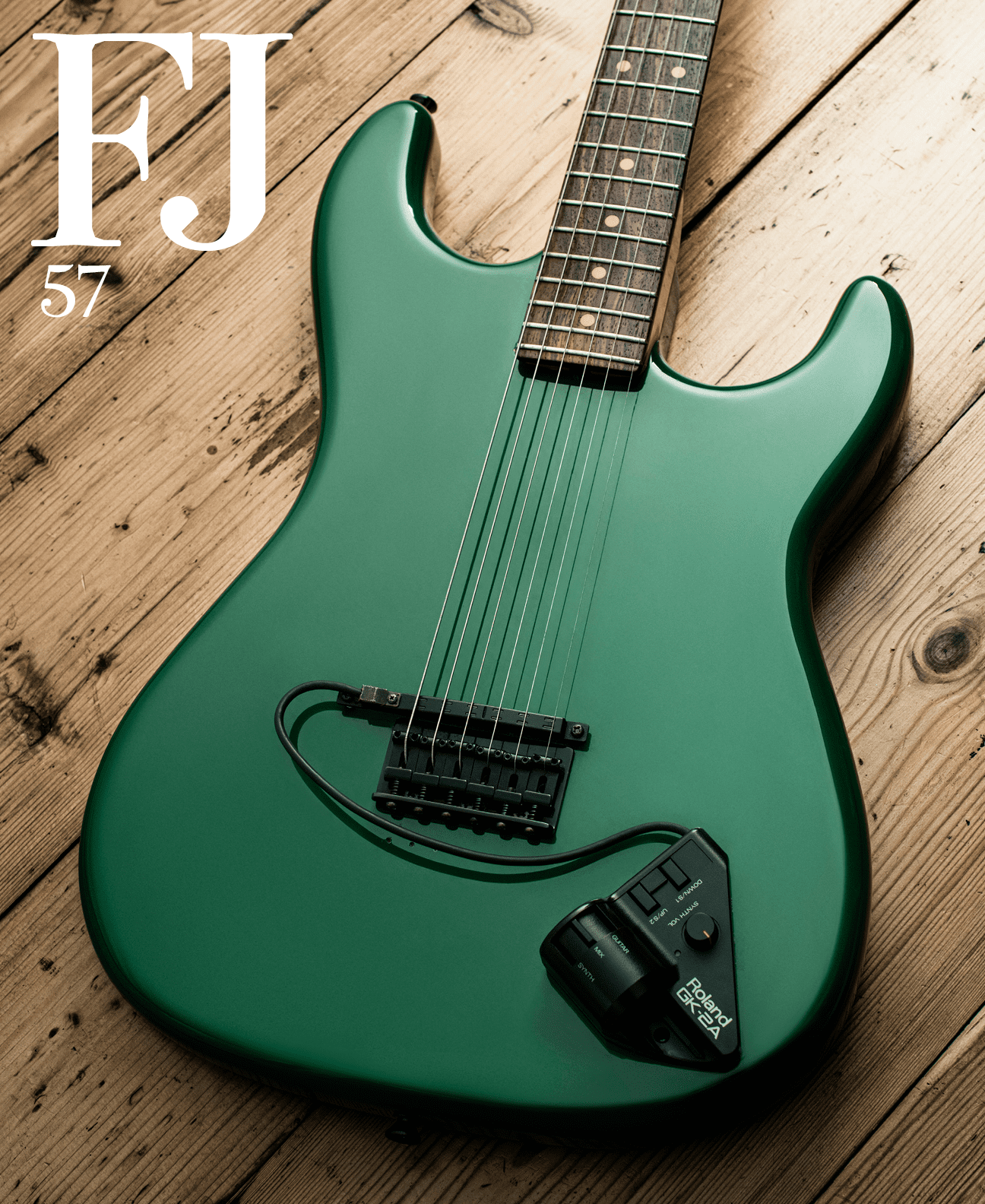
The post What’s Inside: Fretboard Journal 57 first appeared on Fretboard Journal.

